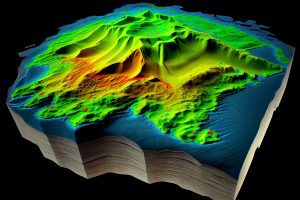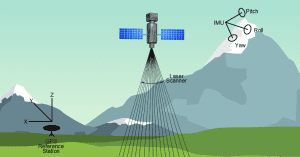Optics for LiDAR and sensing
- LIDAR technology has seen huge advances in recent years.
- Different applications require different types of lasers
- Custom optics can enable you to create a LIDAR system optimized for your application.
Optics for LIDAR and sensing are far more affordable today than they were just ten years ago, and the technology is currently accessible to almost anyone. In fact, if you carry around a newer iPhone Pro, you’ve got your own mini LIDAR system, though it may be there more as a novelty than for any practical purpose.
Light Detection and Ranging (LiDAR) was first introduced in 1961, not long after the laser was invented, as a method to track satellites by measuring the time it took for a laser signal to return. A LiDAR altimeter was used to map the surface of the moon in 1971, but the device was enormous, expensive, and gave subpar results. Today, improved technology is used to create maps, elucidate archeological sites, and provide the vision needed for autonomous vehicles. But that’s just a few of the thousands of uses of this key photonic technology.
But just what is LiDAR, and what optics are needed for a successful, high performance system? That’s what we’ll look at here. First questions first: what is LiDAR, and how does it work?
What Is LiDAR?
A LiDAR system is the photonic analagy of radar. Light from a precisely directed, rapidly firing laser is bounced off an object or terrain. On its return, time of flight calculations give the exact distance between two points, information that can be used to create detailed 3D models or topographical maps.

Laser for LiDAR
A LiDAR system can be designed to use UV, vis, or NIR lasers. The laser selected depends on the objects being surveyed and the environment the imaging takes place in.
Non-scientific applications typically use 600-1000 nm lasers, but care must be taken since these wavelengths can be damaging to the human eye. Er-doped fiber 1550 nm lasers are the preferred option for many military applications, as they are both relatively eye-safe and not visible to night vision goggles. They are also used for topography mapping, measuring distance, and obstacle avoidance, but they rely on InGaAs sensors and are therefore more expensive to use LIDAR based on lower-wavelength lasers.

For underwater and bathymetry applications, you need a laser that has good transmission in pure water as well as limited backscattering from the small particles that will be encountered in seawater. we recommend 534 nm frequency-doubled diode pumped YA lasers. These lasers penetrate water with minimal attenuation. For airborne topographic mapping, 1064 nm diode-pumped YAG lasers are preferable.
Other key laser parameters key to your LiDAR setup include pulse repetition rate, laser power consumption, and beam divergence. You will also need to choose between flash LiDAR, in which the whole field of view is illuminating at once, or more conventional scanning LiDAR which goes over the field of view point by point.
Controlling the Spectral Width with Bandpass Filters
When laser at 1064 nm is used for long range airborne LiDAR systems, one challenge to be overcome involves the high levels of background noise created by radiance from the sun. Signal to noise ratio can be increased by fitting the LiDAR receiver with a narrow bandpass filter. Harsh environmental conditions necessitate a robust filter that can perform consistently and reliably. Multilayer thin film coatings that provide transmission narrowly matching the laser wavelength are often chosen.
When narrow linewidth meter-oscillator power-amplifier (MOPA) based pulsed lasers are used, the central wavelength is determined by the seeding laser pulse but is affected by numerous diode conditions (temperature stabilization, drive current, and pulse repetition rate, among others). Wavelength control is no longer simple, and in this situation a bandpass filter should be chosen with a band wide enough to allow for any expected wavelength shifts.
Custom LiDAR Systems
At Avantier, we focus on custom optics that are tailor-made to meet our customers’ exact specifications. LiDAR is one field where there is no one size fits all, and if you try to fit a ready-made solution into your application you’re sure to run into frustration. A better option is to work with our optical engineers and designers to order a system custom-made to your specifications. Sound intriguing? Contact us today to start exploring your possibilities or set up an initial consult with one of our experts in LiDAR technologies.
GREAT ARTICLE!
Share this article to gain insights from your connections!



